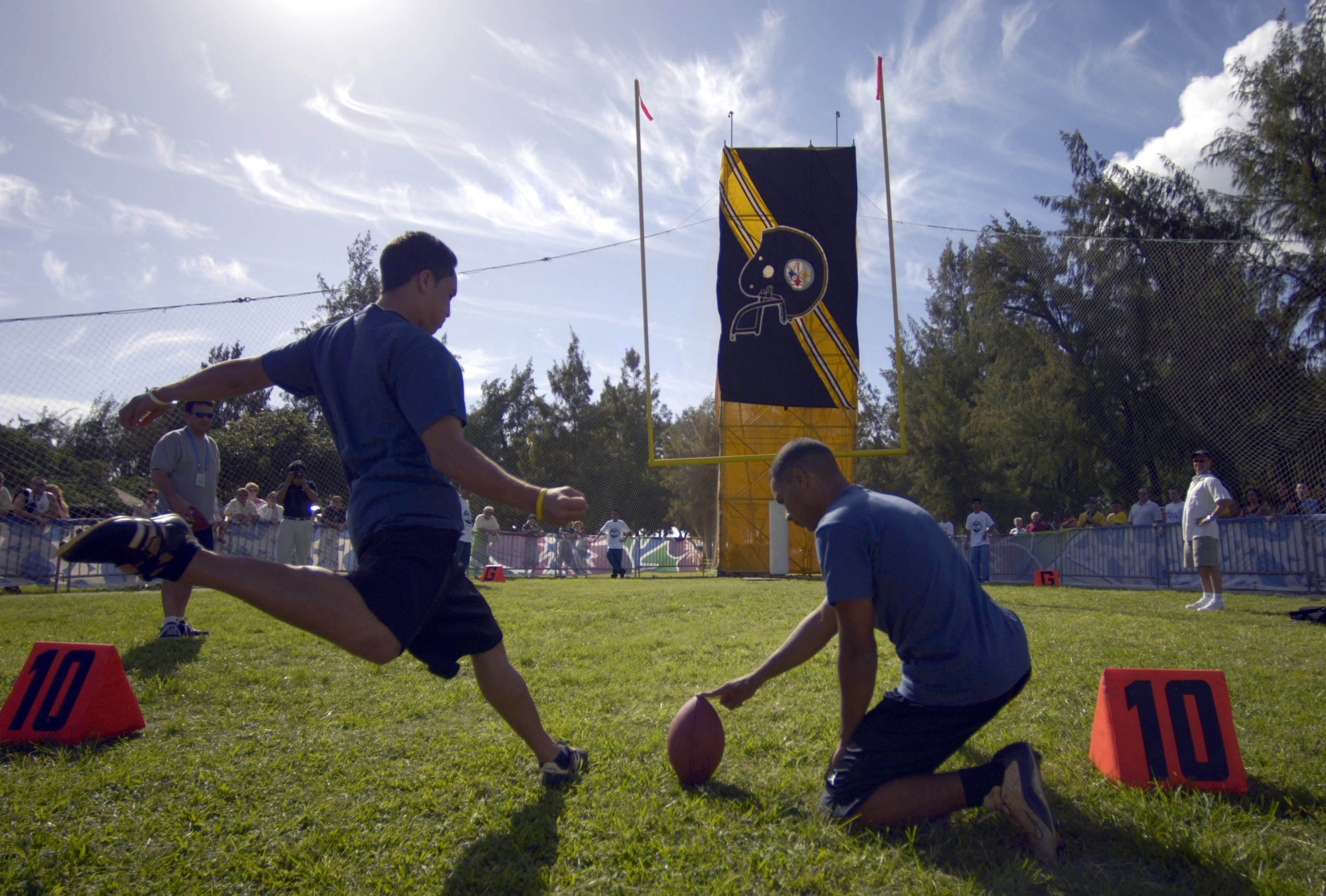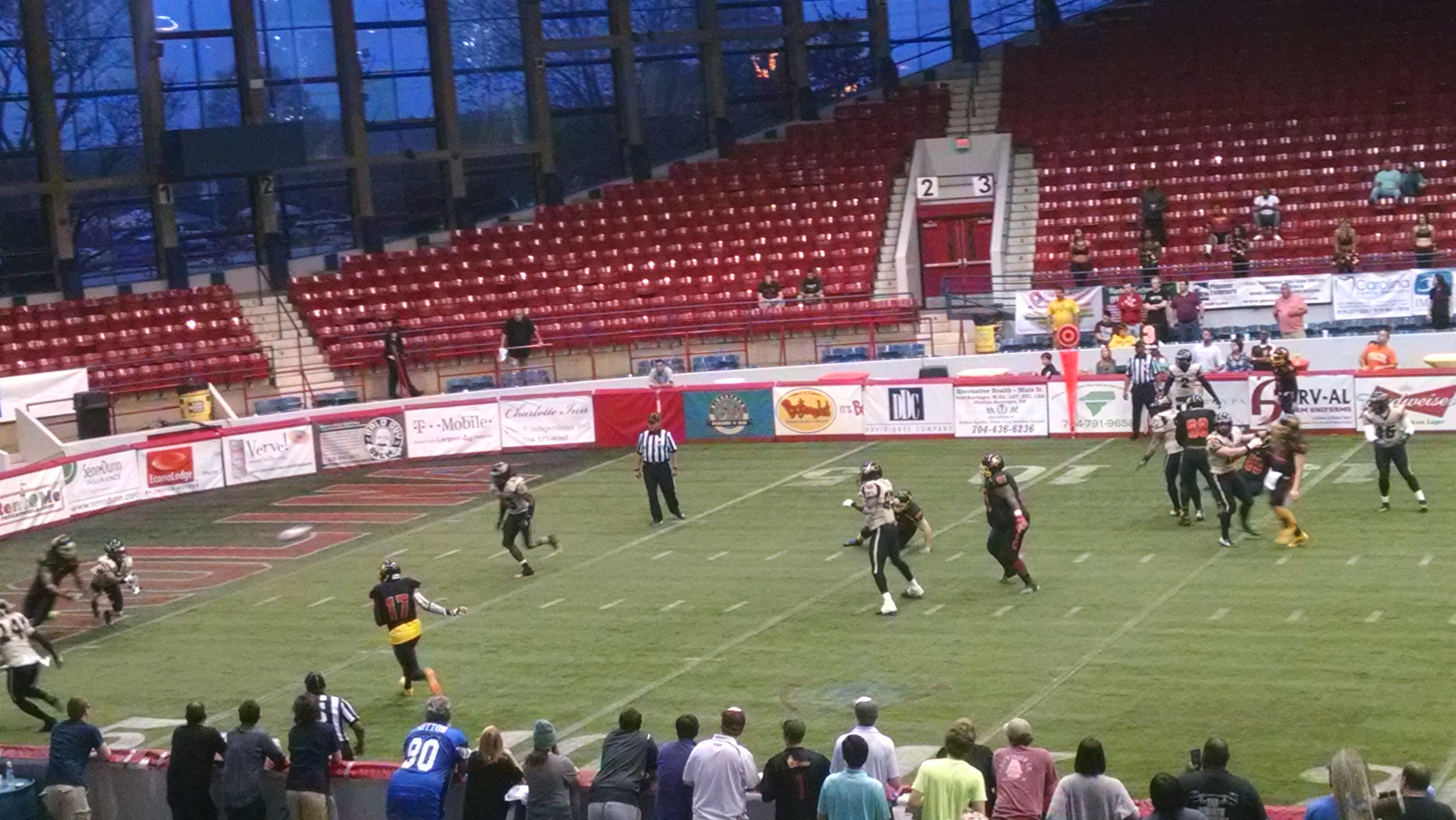|
Offensive Specialist
In arena football, a specialist was a player, other than a quarterback or placekicker, who was exempt from the league's one-platoon system ("Iron Man"). Under the original Arena football system, six of the eight players on each team were required to play both offense and defense. One of the two offensive positions was required to be a quarterback or, in the event of a kick, a placekicker. The other was known as an ''offensive specialist'' (OS). Offensive specialists usually played wide receiver, either as a flanker or a slotback. The defense was allowed two ''defensive specialists'' (DS), who almost universally played in the secondary. Players were referred to as "specialists" instead of their more traditional positional designations (example, a player would be called a defensive specialist, and be designated as "DS" on a position chart, instead of a cornerback or CB). Specialists were usually required to participate on special teams, a requirement that was not extended to quar ... [...More Info...] [...Related Items...] OR: [Wikipedia] [Google] [Baidu] |
Arena Football
Indoor American football, or arena football, is a variation of gridiron football played at ice hockey-sized indoor arenas. While varying in details from league to league, the rules of indoor football are designed to allow for play in a smaller arena. It is distinct from traditional American or Canadian football played in larger domed or open-air stadiums, although several early college football games contested on full-sized or nearly full-sized fields at Chicago Coliseum (1890s) and Atlantic City Convention Center (1930s and 1960s) helped to show that football could be played as an indoor game. History Early history The first demonstration of football on a small field was actually played outdoors at the original open-air Madison Square Garden. Using nine-man sides, Pennsylvania defeated Rutgers 10–0 at the annual meeting of the Amateur Athletic Union on January 16, 1889. The first documented indoor football game was an exhibition between the Springfield YMCA Training Scho ... [...More Info...] [...Related Items...] OR: [Wikipedia] [Google] [Baidu] |
Quarterback
The quarterback (commonly abbreviated "QB"), colloquially known as the "signal caller", is a position in gridiron football. Quarterbacks are members of the offensive platoon and mostly line up directly behind the offensive line. In modern American football, the quarterback is usually considered the leader of the offense, and is often responsible for calling the play in the huddle. The quarterback also touches the ball on almost every offensive play, and is almost always the offensive player that throws forward passes. When the QB is tackled behind the line of scrimmage, it is called a sack. Overview In modern American football, the starting quarterback is usually the leader of the offense, and their successes and failures can have a significant impact on the fortunes of their team. Accordingly, the quarterback is among the most glorified, scrutinized, and highest-paid positions in team sports. '' Bleacher Report'' describes the signing of a starting quarterback as a Catch- ... [...More Info...] [...Related Items...] OR: [Wikipedia] [Google] [Baidu] |
Placekicker
Placekicker, or simply kicker (PK or K), is the player in gridiron football who is responsible for the kicking duties of field goals and extra points. In many cases, the placekicker also serves as the team's kickoff specialist or punter. Specialized role The kicker initially was not a specialized role. Prior to the 1934 standardization of the prolate spheroid shape of the ball, drop kicking was the prevalent method of kicking field goals and conversions, but even after its replacement by place kicking, until the 1960s the kicker almost always doubled at another position on the roster. George Blanda, Lou Groza, Frank Gifford and Paul Hornung are prominent examples of players who were stars at other positions as well as being known for their kicking abilities. When the one-platoon system was abolished in the 1940s, the era of "two-way" players gave way to increased specialization, teams would employ a specialist at the punter or kicker position. Ben Agajanian, who started his ... [...More Info...] [...Related Items...] OR: [Wikipedia] [Google] [Baidu] |
One-platoon System
The one-platoon system, also known as iron man football, is a platoon system in American football where players play on both offense and defense. It was the result of smaller roster sizes in the early days of the game and rules that limited player substitutions, rules that are also standard procedure in many other sports but were eliminated in the 1940s as free substitution was legalized. The alternative system is the two-platoon system (or simply the ''platoon system''), which uses separate offensive and defensive units (three platoons if special teams is also counted). Each system was used at different times in American college football and in the National Football League. One-platoon football is seen in modern times mostly on lower-end and smaller teams at the high school and semi-pro levels, where player shortages and talent disparities require it; the system allows teams to play with a smaller roster than a two-platoon or multiple-platoon team, but because players are on the f ... [...More Info...] [...Related Items...] OR: [Wikipedia] [Google] [Baidu] |
Slotback
Slotback, sometimes referred to as an A-back or slot receiver, is a position in gridiron football. The "slot" is the area between the last offensive lineman on either side of the center and the wide receiver on that side. A player who lines up between those two players and behind the line of scrimmage fills that "slot." The slotback position is a fixture of Canadian football and indoor football where they act as extra receivers. It is also used in American football where the position requires a versatile player, who must combine the receiving skills of a wide receiver, the ball-carrying skills of a running back, and the blocking skills of a tight end. A similarly named position is the slot receiver, who is the third wide receiver in a 3-receiver set, the one who lines up between the outermost receiver and the end of the offensive line. Slotbacks are often as many as five yards behind the line of scrimmage when the ball is snapped and, in the Canadian and indoor game, may ... [...More Info...] [...Related Items...] OR: [Wikipedia] [Google] [Baidu] |
Defensive Back
In gridiron football, defensive backs (DBs), also called the secondary, are the players on the defensive side of the ball who play farthest back from the line of scrimmage. They are distinguished from the other two sets of defensive players, the defensive linemen who play directly on the line of scrimmage, and the linebackers, who play in the middle of the defense, between the defensive line and the defensive backs. Among the defensive backs, there are two main types, cornerbacks, which play nearer the line of scrimmage and the sideline, whose main role is to cover the opposing team's wide receivers, and the Safety (gridiron football position), safeties, who play further back near the center of the field, and who act as the last line of defense. American defensive formations usually includes two of each, a left and right cornerback, as well as a strong safety and a free safety, with the free safety tending to play further back than the strong safety. In Canadian football, which ha ... [...More Info...] [...Related Items...] OR: [Wikipedia] [Google] [Baidu] |
Cornerback
A cornerback (CB) is a member of the defensive backfield or secondary in gridiron football. Cornerbacks cover receivers most of the time, but also blitz and defend against such offensive running plays as sweeps and reverses. They create turnovers through hard tackles, interceptions, and deflecting forward passes. Other members of the defensive backfield include strong and free safeties. The cornerback position requires speed, agility, strength, and the ability to make rapid sharp turns. A cornerback's skill set typically requires proficiency in anticipating the quarterback, backpedaling, executing single and zone coverage, disrupting pass routes, block shedding, and tackling. Cornerbacks are among the fastest players on the field. Because of this, they are frequently used as return specialists on punts or kickoffs. Overview The cornerback’s chief responsibility is to defend against the offense's pass. The rules of American professional football and American coll ... [...More Info...] [...Related Items...] OR: [Wikipedia] [Google] [Baidu] |
Special Teams
In American football, the specific role that a player takes on the field is referred to as their "position". Under the modern rules of American football, both teams are allowed 11 players on the field at one time and have "unlimited free substitutions", meaning that they may change any number of players during any "dead ball" situation. This has resulted in the development of three task-specific "platoons" of players within any single team: the offense (the team with possession of the ball, which is trying to score), the defense (the team trying to prevent the other team from scoring, and to take the ball from them), and the so-called 'special teams' (who play in all kicking situations). Within these three separate "platoons", various positions exist depending on the jobs that the players are doing. Offense In American football, the offense is the team that has possession of the ball and is advancing toward the opponent's end zone to score points. The eleven players of the offen ... [...More Info...] [...Related Items...] OR: [Wikipedia] [Google] [Baidu] |
Arena Football League
The Arena Football League (AFL) was a professional arena football league in the United States. It was founded in 1986, but played its first official games in the 1987 season, making it the third longest-running professional football league in North America after the Canadian Football League (CFL) and the National Football League (NFL) until the AFL closed in 2019. The AFL played a formerly proprietary code known as arena football, a form of indoor American football played on a 66-by-28 yard field (about a quarter of the surface area of an NFL field), with rules encouraging offensive performance, resulting in a typically faster-paced and higher-scoring game compared to NFL games. The sport was invented in the early 1980s and patented by Jim Foster, a former executive of the United States Football League (USFL) and the NFL. Each of the league's 32 seasons culminated in the ArenaBowl, with the winner being crowned the league's champion for that season. From 2000 to 2009, the AF ... [...More Info...] [...Related Items...] OR: [Wikipedia] [Google] [Baidu] |
Indoor American Football
Indoor American football, or arena football, is a variation of gridiron football played at ice hockey-sized indoor arenas. While varying in details from league to league, the rules of indoor football are designed to allow for play in a smaller arena. It is distinct from traditional American or Canadian football played in larger domed or open-air stadiums, although several early college football games contested on full-sized or nearly full-sized fields at Chicago Coliseum (1890s) and Atlantic City Convention Center (1930s and 1960s) helped to show that football could be played as an indoor game. History Early history The first demonstration of football on a small field was actually played outdoors at the original open-air Madison Square Garden. Using nine-man sides, Pennsylvania defeated Rutgers 10–0 at the annual meeting of the Amateur Athletic Union on January 16, 1889. The first documented indoor football game was an exhibition between the Springfield YMCA Training School ... [...More Info...] [...Related Items...] OR: [Wikipedia] [Google] [Baidu] |


